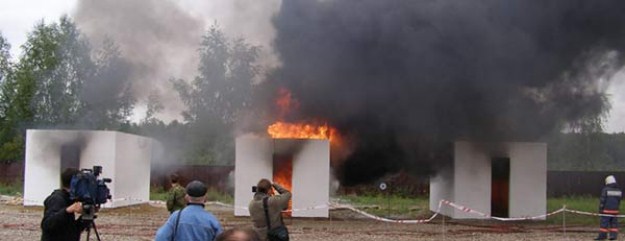September 11, 2007 on the basis of EMERCOM Russia held a scientific workshop «Issues of fire safety coatings based on metal profiled sheet.» The seminar deals with the theoretical and practical aspects of fire safety flat roofs with combustible materials, methods of testing, the state fire regulation in construction, insurance facilities, taking into account their level of fire protection. Institute at the landfill were conducted demonstration experiments.
The theoretical part of the conference was opened by Deputy Head EMERCOM of Russia, Doctor of Technical Sciences, Professor IA Bolodyan, who in his opening remarks, highlighted the current problems of fire safety of buildings and structures. He noted that one of the important activities of the Institute is to develop advanced methods of testing of building structures and materials, an objective assessment of fire danger and fire safety rationale for their use, especially in buildings crowded with people on the unique and critical facilities. Given the fire danger insulation and roofing materials proposed to develop appropriate recommendations for the use of structural coatings based on metal profiled sheet.

The test is «a small burner.» Left to right: extruded polystyrene, polystyrene, phenol-resol foam, polyurethane foam, Rockwool, 1 — 10 sec, 2 — 1 minute, 3 — 5 minutes from the start of the test
A report entitled «Characteristics and prospects for testing insulation and roofing materials» was made head of EMERCOM of Russia, Doctor of Technical Sciences, Professor NV Smirnov, who spoke about the methods for determining fire danger rating of construction materials, operating in our country and the EU.
Now in Russia there was a difficult situation in the field of certification of building materials for their fire safety. Domestic standards differ from the European, and not for the better. In our country the fire hazard of building materials is determined by characteristics such as flammability (B1-B3), flammability (T1-T4), the spread of flame over the surface (WP1-WP4), smoke-forming ability (D1-D3) and the toxicity of combustion products (T1 -T4). In the European classification, all materials are divided into seven classes, from A1 to F. In addition, in the West introduced this criterion as «calorific value», which in our country is not considered. However, this criterion is very important because it is directly related to other characteristics of fire hazard materials.
NV Smirnov recommended to specialists in the audience not to apply in their work with a measure of insulation materials G3 or G4, but also to the materials mentioned in the certificate which G1 and G2, in his opinion, too, should be treated with caution. The speaker drew attention of participants to the fact that the results obtained in some laboratory test data for groups of combustibility T and T2 for the insulation of expanded polystyrene and extruded polystyrene are not confirmed in other laboratories, and are probably incorrect.
The main problem of the Russian system of certification, paradoxically — the absence of the system. At the present time in our country to issue fire safety certificates accredited laboratories around one hundred. For comparison: in Germany there are only eight.
According to NV Smirnova, it’s time to move Russia to the European standards. «We plan for two years as an experimental test of roofing materials used on the European classification in parallel with the Russian system.» EMERCOM specialists are ready for this, the institute has all the necessary equipment.
A report on «Fire danger coating designs and methods of test» was made Chief of the Russian EMERCOM ST Lezhnev. In his report, he told the participants about the danger of fire insulation materials of expanded polystyrene combined with bitumsoderzhaschimi roofing materials. The presentation provided examples of fires at facilities that were built with the use of expanded polystyrene insulation, with disastrous consequences (Chernobyl, Nadim, Chelyabinsk). When fighting fires at these facilities is very complicated work of the rapid spread of fire to insulation (structures collapse occurred by the 12-14th minutes of the fire), the emission of toxic combustion products.
The recommended design and construction organizations, ST Lezhnev suggested use of flammable materials from expanded polystyrene and extruded polystyrene foam composite structures only in conjunction with mineral wool slabs of high density.
The experimental part of the workshop included test firing insulating materials used in roofing structures, on the stands, as well as large-scale fire tests on fragments of buildings.
Tests at the stand — the so-called small burner — provides simultaneous exposure of five flame gas burners for five samples of insulating materials: polystyrene, extruded polystyrene, phenol-resol foam (FRP), polyurethane (PUR) foam and mineral wool.
The experiment showed the following: polystyrene foam for a few seconds, melted and burned, charred foam and FRP have been observed on the surface of the flame runs, a sample of mineral wool has remained virtually unscathed.
Large-scale experiments were carried out by a special method, whose purpose was to conduct a comparative evaluation of structures, including various types of insulation (expanded polystyrene, extruded polystyrene and mineral wool), the thermal effects of the fire below. To do this, «houses» were set alight piles of sticks of wood.
Roof design of experimental facilities consisted of a profiled sheet, insulation (at each facility — a) and asphalt roll roofing material. Roofs with insulation of expanded polystyrene caught fire quickly, the sky went black toxic smoke poles. However, quite quickly caught fire and the roof with mineral wool — in spite of the non-combustible insulation, the fire still spread to the bituminous roofing carpet.

Tests for Roof construction. Left right: with mineral wool insulation, foam, extruded polystyrene
According to organizers, the experiments demonstrated a high fire hazard construction coating, having in its composition combustible insulation. However, as a result of all those present have seen a fire of bituminous roofing materials and asked the question: why this demonstration, if the expanded polystyrene insulation used today, usually in closed structures?
